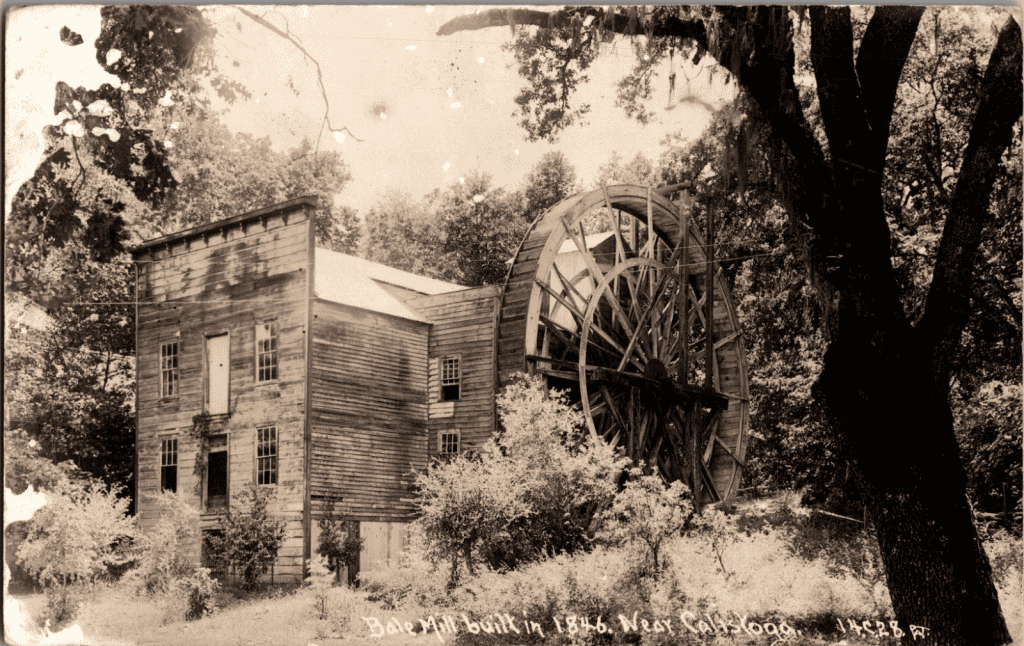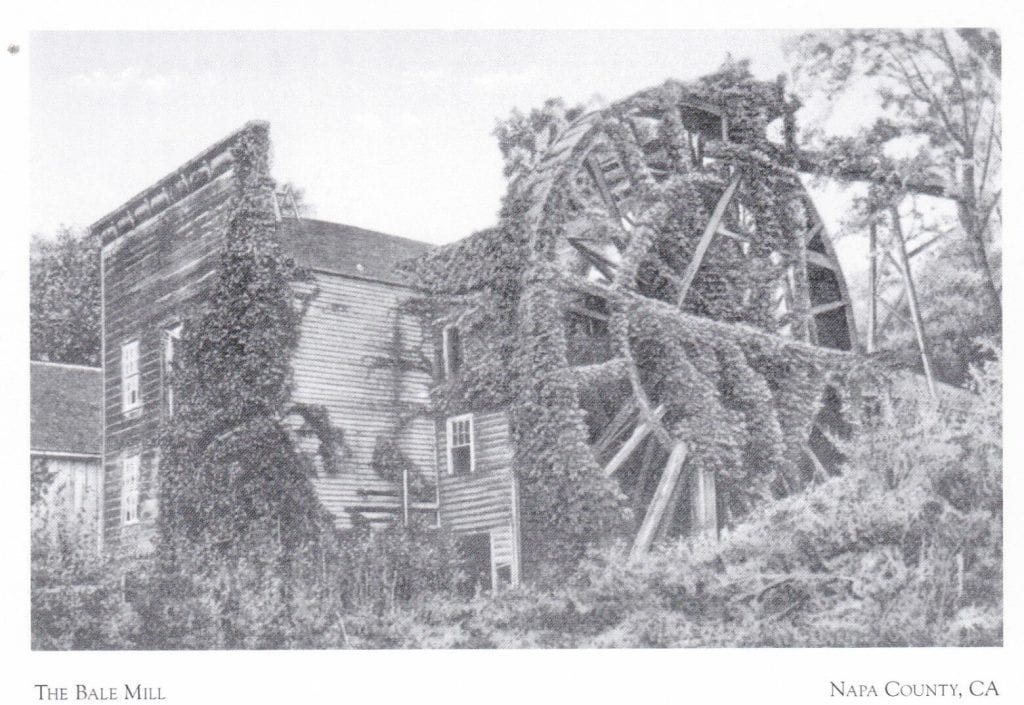A month or so ago, late in November, there was an email in the editor’s inbox with the message, “Check this out!” Then another with the same message came a couple days ago. The last time, the email had a file attachment that showed a ship named the S. S. Warrimoo. The story that followed was about a sea-captain with a sense of humor who was able to position his ship in the Pacific Ocean at a certain time at the exact longitude and latitude where the Equator and the International Dateline intersect. It turned out to be a fascinating tale entitled At Midnight in Moonlight, published on December 7th.
This time, Post-Hist’s unknown correspondent has sent another email with an image of an ancient gristmill in the hills of the Napa Valley, just north of San Francisco. Admitting that the picture captured interests in things imagined from afar, borders on understatement. From cult to occult, shall we examine the card for curiosity’s sake to amuse our anonymous correspondent or just because it’s historic? You be the judge!

Edward Turner Bale was a doctor educated in London who accepted a commission in 1836 to be a ship surgeon on board H.M.S. Harriet. Had he known what was to come his way in the dozen years to follow, he may well have changed that decision.
Being a ship surgeon at that time in history was guaranteed passage to every port the ship visited. Harriet’s itinerary for 1837 was London to California. It is impossible to know the success of the day-to-day voyage, but it certainly ended badly. Just short of its destination the ship ran aground off the coast of Monterey, California. Dr. Bale was among the very few to escape the wreckage and to make his way to shore.
Once ashore, Bale came to realize the promising situation in which he found himself. The politics of the era aside, the resident doctor in Monterey had recently lost an electoral struggle with the governor and no longer enjoyed the favor of his fellow citizens. Bale filled the gap. Mostly!
Bale’s medical practice brought him wealth and connections to the highest of California’s elite, even, as reported by a local newspaper, if “… several of his patients never made it off the operating table.” And that, “His intelligence was unassailed and his professional ability respected; but he was quarrelsome, and there were few who could abide that side of his nature.”
Eventually Bale married well and secured a government position and several land-grants that contributed to his ever-growing wealth and social status. But a move to San Francisco stymied his quest for social recognition when a lawsuit was filed against him for selling medicine with an unusually high alcohol content. The same newspaper reported that he was found guilty, and “He was jailed eight days for selling alcohol from his medical offices and was sharply criticized for dispensing medicine at doses dangerously higher than usually prescribed.”
Bale’s name has remained prominent in California history for the grist mill he built on his ranch in the Napa Valley. There were other projects such as saw-mill development, gold mining endeavors, and ranching, but each was in some way the target of litigations that he was unable to control and by 1849 was forced to sell his assets.
After a move to Sutter’s Fort later in the year he developed a fever, and it seems to be commonly known that while at the fort, he became aware that he was dying of stomach cancer.
He died October 9, 1849.
***
The property on which the grist mill was built, through the winter of 1846 and 1847, is now the Bale Grist Mill State Historic Park. It is the site on which Dr. Bale had a water-powered mill that provided flour to the residents of the Napa Valley for more than 35 years. The Bale Mill and others like it improved the lives of many pioneers who lived near and around where they could get help in converting wheat grain and dried corn to meals and flours useable in primitive kitchens. Those who wished to avail themselves of the miller’s skill would drop their grain into a boot of an elevator to be mechanically transported upstairs to be cleaned and sifted by various types of equipment. The slow turning of the grind stones rendered the fresh meal into a extremely fine dust with a special quality for making cornbread, shortening bread, and spoon bread.
The overshot water wheel was a tourist attraction since the first day it began to turn.
***
The charm that Bale’s mill has held through the years is mostly artistic. It seemed to enjoy more public attention in the years between the closing of the mill (1879) and the establishment of the state park. It required a scramble, but two postcards showing the abandoned building have been found and they serve well in illustrating this speculation.


The Bale Mill State Historic Park is now protected as a California state historic landmark as well as being listed in the National Register of Historic Places. The mill is operated by Napa Open Space organization in partnership with the Napa Valley State Parks Association. The park contains the still functioning mill as well as the first church founded in the Napa Valley, and the historic Pioneer Cemetery.
That is a fascinating history. I wonder how many more interesting stories are behind mill postcards. Thank you for sharing.
Had Bale’s ship wrecked a few decades later, he might well have found himself running afoul of immigration authorities had he attempted to settle so casually in California.
Another great bit of history. I did business as a salesperson in the Calistoga area for years but never knew of this story or this place. As a native Californian and a true history buff, I am so glad that you educated me on this Ray, thank you.
Thanks for the previous story too. Very interesting!
How interesting. I assume that the mill was restored at some point? I say this because the wheel itself as well as a lot of the whole building is covered in ivy in the final photo.